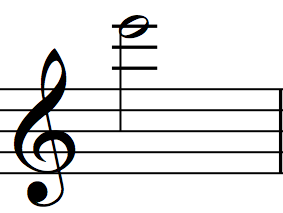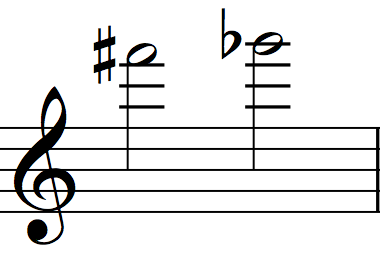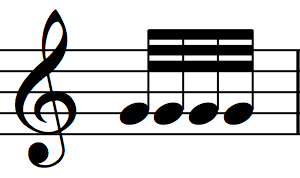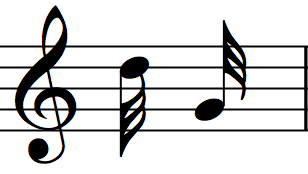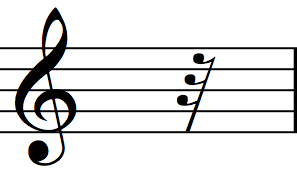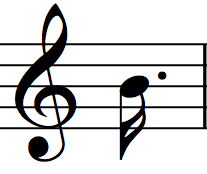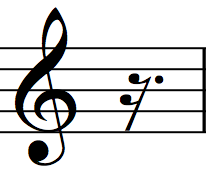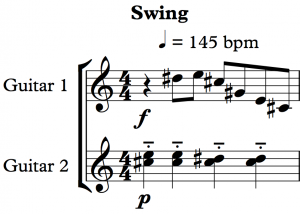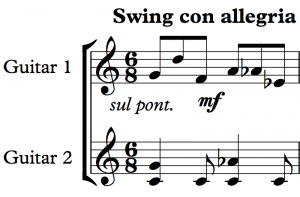18 More Notes, Thirty-Second Rhythms & Swing
INTRODUCTION
In this unit you will learn more fretted notes on the first string, thirty-second note rhythms and different methods for notating swing rhythm.
NOTATIONS
Notes
The Note ‘E’
‘E’ is in the third leger line above the staff. To play ‘E,’ fret the twelfth fret on the first string.
The Note ‘F’
‘F’ sits on top of the third leger line above the staff. To play ‘F’ fret the thirteenth fret on the first string.
The Notes ‘F♯’ or ‘G♭’
‘F♯’ and ‘G♭’ are enharmonics. To play ‘F♯’ or ‘G♭’, fret the fourteenth fret on the first string.
The Note ‘G’
‘G’ sits on top of the fourth leger line above the staff. To play ‘G’ fret the fifteenth fret on the first string.
Rhythms
Thirty-Second Note in Simple Meter
A thirty-second note sustains for one-eighth of a beat in simple meter. The thirty-second note can be written in two ways: either with three beams or three flags.
Beamed Thirty-Second Notes
This example contains four thirty-second notes.. The thirty-second note consists of a note head that is colored in, a stem and three beams.
Flagged Thirty-Second Notes
In this example, the thirty-second notes contain flags instead of beams.
Thirty-Second Rest
A thirty-second rest creates silence for one-eighth of a beat in simple meter. It consists of a diagonal line with three small flags.
How to Count Thirty-Second Notes in Simple Meter
It’s impossible to count thirty-second notes in a methodical manner at a brisk tempo, simply because they proceed faster than most of us can count. Therefore, it is best to devote part of your practice to recognizing and playing different combinations of thirty-second and sixteenth notes. Aim to play them in relation to the pulse in an intuitive (not intellectual) manner. However, while developing this skill, it will help to slow down the pulse and count according to the method below. When this becomes manageable, speed up the pulse (little by little) until you count only the pulse, not the rhythmic sub-divisions of the pulse.
I recommend counting in the manner described above (view the video for a demonstration). The first eighth of the beat receives a number, which represents the its placement in the measure. The second eighth of the beat receives the sound ‘di.’ The third eighth of the beat receives the sound ‘ee.’ The fourth eighth of the beat receives the sound ‘da.’ The fifth eighth of the beat receives the sound ‘&.’ The sixth eighth of the beat receives the sound ‘di.’ The seventh eighth of the beat receives the sound ‘ah.’ The last eighth of the beat receives the sound ‘da.’
Bear in mind that thirty-second notes are usually ornamental. When applicable, it will help to recognize them as a trill, turn, mordent, etc. Further, ornaments are often played with a greater degree of expression and flexibility because they are not as structurally important as melody. Despite this fact, many composers request that musicians perform thirty-second notes and ornaments with rhythmic precision.
Dotted Sixteenth Note & Rest in Simple Meter
The dotted sixteenth note sustains for three-quarters of a half of a beat in simple meter.
Dotted Sixteenth Note
The dotted sixteenth note consists of a sixteenth note with a dot positioned close to the notehead.
Dotted Sixteenth Rest
The dotted sixteenth rest creates silence for three-quarters of a half of a beat. The dotted sixteenth rest consists of a sixteenth rest with a dot positioned close to the symbol.
Dotted Sixteenth & Thirty-Second Note Combinations in Simple Meter
The dotted sixteenth and thirty-second note frequently beam together to form recognizable groups. Two combinations are above. View the video for a demonstration.
Sixteenth & Thirty-Second Note Combinations in Simple Meter
Sixteenth and thirty-second notes frequently beam together to form recognizable groups. Three combinations are above. View the video for a demonstration.
Meters for Swing Rhythm
Many of you already know swing rhythm, as it is central to blues and jazz music. Swing rhythm involves a consistent and asymmetrical subdivision of the beat that (in most cases) can’t be accurately represented using the rhythmic symbols available standard notation. As a result, the notation used to represent swing is only an approximation of the rhythm itself. Nonetheless, musicians have attempted to notate swing rhythm in various ways for over a century. In nearly all cases, the word swing is written above the time signature.
Most musicians advocate to notate swing rhythm in simple meter, as in the example above from Swing by Emile Porée. In this piece each eighth-note grouping (as seen in Guitar 1) should not be played straight—with equal subdivisions of the beat. Instead, each eighth-note grouping should be swung—with asymmetrical subdivisions of the beat. The beat subdivision in swing is often described as long-short or doo-bah. View the video for a demonstration.
Shuffle rhythm is a type of swing rhythm that can be noted accurately. It occurs when the asymmetrical subdivision of the beat adheres to a 2:1 ratio. This rhythm is typically notated in simple meter (like other forms of swing) with the word shuffle (or swing) written above the time signature. However, in the example above from Crazy Vertical Blues by Joan Greenwald, shuffle rhythm (as seen in the Guitar 2 part) is notated in compound meter. View the video for a demonstration.
Let’s Play |
Sight-Reading Tip
If you are interested in developing swing rhythm, bear in mind that there are many ways to swing! Further, the swing feel is achieved by a combination of articulation, phrasing and rhythm. Therefore, I suggest you listen to great blues and jazz musicians, emulate their swing and eventually play in a way that feels right for you.
Checklist for Sight-Reading
- Count the beats out loud (including the &).
- Keep going (even if you make a mistake).
- Maintain your best playing posture.
- Look at the score, not your hands.
- Play with the feel of the meter.
- Play patterns instead of individual notes (AKA chunk).
- Cultivate a calm demeanor.
- Have fun!
Let’s Play Rhythms |
Attitude Tip
The measure of who we are is what we do with what we have. –Vince Lombardi
Exercise 18.1: Score
Exercise 18.1: Audio
Exercise 18.2: Score
Exercise 18.2: Audio
Exercise 18.3: Score
Exercise 18.3: Audio
Let’s Play Patterns |
Attitude Tip
Perfection is not attainable, but if we chase perfection we can catch excellence. –Vince Lombardi
Exercise 18.4: Score
Exercise 18.4: Audio
Exercise 18.5: Score
Exercise 18.5: Audio
Exercise 18.6: Score
Exercise 18.5: Audio
Let’s Play Duets |
Attitude Tip
The greatest accomplishment is not in never falling, but in rising again after you fall. –Vince Lombardi
Pavana I by Luis de Milán: Score
Pavana I: Audio
Let’s Play Compositions |
These compositions are under the Creative Commons Attribution-NonCommercial 4.0 International License (CC BY-NC 4.0).
Attitude Tip
We would accomplish many more things if we did not think of them as impossible. –Vince Lombardi
Swing by Emile Porée: Score
Swing: Audio
Crazy Vertical Blues by Joan Greenwald: Score
Crazy Vertical Blues: Audio
Obelisk No. 4 by Ashraf Fouad: Score
Obelisk No. 4: Audio
The next piece contains a refrain. The refrain starts at the Segno (on the first page, third system) and ends at the Coda (on the first page, fourth system). Notice that the piece is divided into four major sections, labeled A, B, C and D. When you see the Segno/Coda symbols in Sections B, C, and D jump back to the beginning of the refrain in Section A. At the end of the refrain, when you encounter the Coda, jump back to the Coda in either the B, C, or D sections.
Guitar Samaie by Ashraf Fouad: Score
Guitar Samaie: Audio
Congratulations!
You have completed this unit! If you kept up with the beat and accurately played approximately 70% of the pitches and rhythms, you are ready for the next unit. Feel free to repeat the exercises. However, do not play them so often that you memorize them. Once you memorize the notation, you are no longer developing the skill of sight-reading.

